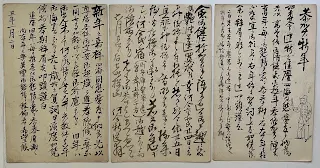Introduction to the Collection
This set of 18 postal cards, sent between 1888 and 1891, documents the correspondence of Kawai Shinzō (河合新造 / 河合新蔵, 1867–1936) during his formative years as an aspiring artist. Addressed to his teacher, Maeda Yoshihiko—a Western-style painter based in Kobe—the cards reflect Kawai’s close relationship with his mentor as well as his artistic growth. The earliest cards were sent from Osaka, where Kawai began his studies, and the later ones from Tokyo, following his move there in 1891 to continue his training under Goseda Yoshiryu and Koyama Shōtarō. Presented in chronological order, this correspondence not only offers rare insight into the student years of a future master of Japanese watercolor, but also illustrates the evolution of his personal identity, as seen in his alternating use of the names 新造 and 新蔵.
-
January 3, 1888 – Osaka
-
June 24, 1888 – Osaka
-
January 2, 1889 – Osaka
-
July 29, 1889 – Osaka
-
January 1, 1890 – Osaka
-
February 14, 1890 – Osaka
-
May 7, 1890 – Osaka
-
June 3, 1890 – Osaka
-
April 26, 1891 – Tokyo
-
August 4, 1891 – Tokyo
-
August 12, 1891 – Tokyo
-
August 20, 1891 – Tokyo
-
September 15, 1891 – Tokyo
-
September 27, 1891 – Tokyo
-
October 1, 1891 – Tokyo
-
October 24, 1891 – Tokyo
-
October 30, 1891 – Tokyo
-
November 23, 1891 – Tokyo
Introduction
Kawai Shinzō (1867–1936) was a notable Japanese painter who played a significant role in the development of modern Japanese art, especially in the field of watercolor painting. He was influenced by both traditional Japanese techniques and Western methods, which he encountered during his studies abroad. His engagement with various art societies and exhibitions, along with his innovations in watercolor, secured his place in the history of Japanese art during the Meiji and Taishō periods. This post traces Kawai’s life, education, career, and artistic achievements, highlighting the key milestones that shaped his work.
Early Life and Education
Born on May 27, 1867, in Osaka during the Keiō era, Kawai began his artistic training in traditional Japanese painting. He studied under Suzuki Raisai and Maeda Yoshihiko, both of whom introduced him to Western-style techniques. This early exposure would leave a lasting impression on Kawai’s artistic direction.
In 1891, at age 24, he moved to Tokyo to further his studies. He trained at the studio of Goseda Yoshiryu (五姓田芳柳) and later with Koyama Shōtarō at Futōsha (不同舎). These mentors helped refine his oil painting skills while encouraging an emphasis on realism. During this period, Kawai became increasingly engaged with Tokyo’s evolving art scene, shaped by Japan’s broader modernization and openness to Western art.
Studies Abroad
A turning point came in 1900 when Kawai traveled to the United States with fellow artists such as Mitsutani Kunishirō and Kanokogi Takashirō. The following year, he moved to France to study at the Académie Julian and Académie Colarossi in Paris. These institutions provided a rigorous foundation in Western academic painting, including realism and impressionism.
While immersed in the Parisian avant-garde, Kawai remained rooted in Japanese aesthetics, often depicting traditional subjects such as landscapes and nature. After several years in Europe, he returned to Japan in 1904 and settled in Kyoto, continuing to balance modern and traditional approaches in his work.
Return to Japan and Career Developments
Back in Japan, Kawai became active in the modern art scene. He joined the Pacific Painting Society (太平洋画会) in 1904 and exhibited at its third show. His involvement with such groups established him as part of the new generation of Japanese artists who blended Western methods with Japanese sensibilities.
In 1906, he co-founded the Japanese Watercolor Painting Research Institute (日本水彩画研究所) with artists like Ōshita Tōjirō. The institute played a key role in elevating watercolor as a respected medium in Japan. Kawai’s own work during this time demonstrated his refined ability to depict the subtleties of nature through watercolor.
He also participated in major government-sponsored exhibitions such as the Bunten (文展) and Teiten (帝展). In 1907, his piece Mori (Forest) was shown at the first Bunten, followed by Ryokuin (Green Shade) at the second in 1908. These exhibitions helped confirm his position as one of Japan’s foremost watercolor painters.
Involvement in Art Societies and Achievements
Kawai’s deep commitment to watercolor painting led him to co-found the Japanese Watercolor Painting Association (日本水彩画会) in 1913. That same year, he received third prize at the 7th Bunten for Poplar and Summer Oranges (ポプラーと夏蜜柑), a work that demonstrated his technical mastery and artistic sensitivity.
He remained active in official exhibitions, including the Imperial Exhibition (帝展), and was affiliated with the prestigious Second Division. These roles ensured his work continued to gain wide recognition during his lifetime.Later Years and Legacy
Kawai spent his later years in Murasakino, Kyoto, where he continued to paint until his death on February 15, 1936, at the age of 68. His contributions to watercolor painting and modern Japanese art remain influential.
A key figure in Japan’s watercolor movement, Kawai successfully integrated traditional Japanese themes with Western techniques. Through his art, participation in societies, and mentorship of younger artists, he helped shape the course of modern Japanese painting during a pivotal era of change.Conclusion
Kawai Shinzō’s life and career reflect the broader transition of Japanese art during the Meiji and Taishō periods—from classical forms to the incorporation of Western styles. His studies in France, his leadership in art societies, and his commitment to watercolor helped define a unique style that bridged two artistic traditions. His legacy endures in the history of Japanese art and continues to inspire new generations.
Note: Based on our review of available correspondence, it appears that Kawai Shinzō preferred the name 河合新造 over 河合新蔵, at least prior to gaining prominence as an artist.












No comments:
Post a Comment